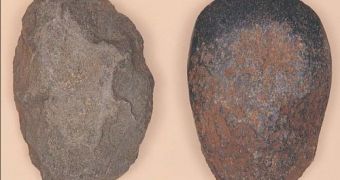The world's oldest ground-edge stone tool was discovered in northern Australia by a team of international experts and Dr Bruno David, a Monash University archaeologist and member of the team.
The artifact was discovered during archaeological excavations organized in May 2010 at Nawarla Gabarnmang – a large rock-shelter in Jawoyn Aboriginal country in southwestern Arnhem Land, in northern Australia.
The rock shelter was discovered by Ray Whear and Chris Morgan from the Jawoyn Association during a helicopter flight on June 15, 2006.
The team of international archeologists having discovered the ax include Hugues Plisson from the Centre National de la Recherche Scientifique at the University of Bordeaux in France, Jean-Michel Geneste from the Centre National de Prehistoire of the Ministry of Culture in France, Christopher Clarkson from the University of Queensland, Jean-Jacques Delannoy from the Centre National de la Recherche Scientifique at the University de Savoie in France and Fiona Petchey from the University of Waikato in New Zealand.
Dr Davis explained that “axes fulfilled a unique position within the Aboriginal toolkit as long use-life chopping tools, were labor intensive to manufacture and highly valued.
“During the late 19th and early 20th centuries, axes were understood by local Aboriginal communities to carry with them the ancestral forces which characterized the particular quarry from which they came.
“Their trade across the landscape moved not just the tool itself, but more importantly the symbolic and ancestral forces of their point of origin.
“The Nawarla Gabarnmang ax, found some 40km from its source, is evidence of 35,000 years of the movement of tools, technologies and ideas across the northern Australian landscape.”
“This new evidence for the earliest securely dated ground-edge implement in the world indicates that Australia was an important locale of technological innovation 35,000 years ago.”
“This discovery will assist researchers in Australia and around the world as we examine the evolution of human behavior and the earliest technological advancements,” said Dr. David.
The earliest hominid ancestors that lived some 3.4 million years ago already used a sort of stone tools, but the first who sharpened the edges of the tools, like for axes, were modern humans like Homo sapiens sapiens.
There are much older axes that have been found in New Guinea, but the tools were not ground, said Dr David, and added that “this suggests that ax technology evolved into the later use of grinding for the sharper, more symmetrical and maintainable edges this generates.”
And as this ax is dated to 35,000 years ago, it is far older than those discovered in Japan and northern Australia, dated to 22,000-30,000 years.

 14 DAY TRIAL //
14 DAY TRIAL //